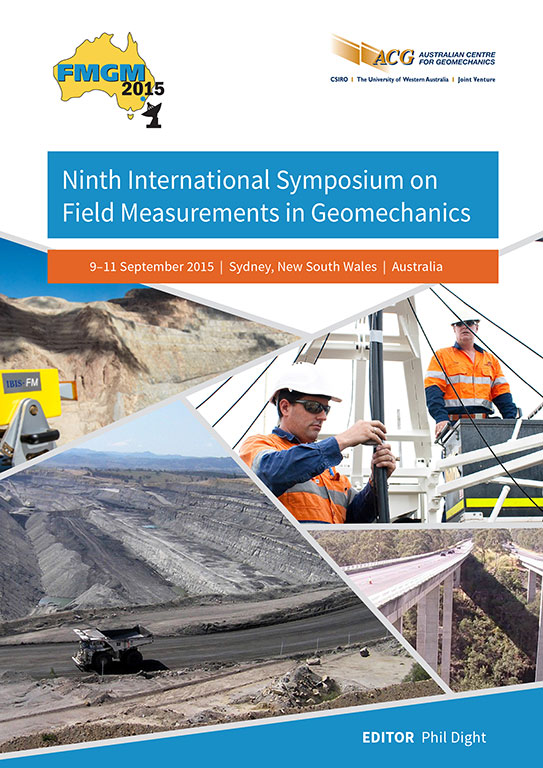Monitoring pavement relief of the Hume Highway during undermining

|
Authors: Swarbrick, GE; Meers, P; Lee Shoy, D; Kay, DJ; Buys, HG |
DOI https://doi.org/10.36487/ACG_rep/1508_47_Swarbrick
Cite As:
Swarbrick, GE, Meers, P, Lee Shoy, D, Kay, DJ & Buys, HG 2015, 'Monitoring pavement relief of the Hume Highway during undermining', in PM Dight (ed.), FMGM 2015: Proceedings of the Ninth Symposium on Field Measurements in Geomechanics, Australian Centre for Geomechanics, Perth, pp. 657-670, https://doi.org/10.36487/ACG_rep/1508_47_Swarbrick
Abstract:
The Hume Highway (M31) is arguably Australia’s most important piece of transport infrastructure, carrying around 45,000 cars, trucks and bases per day, which equates to AUD 22 B worth of goods each year. In 2006, it was proposed to undermine the Hume with a series of long wall panels near Douglas Park, NSW, which would obliquely undermine the dual carriageway causing subsidence of up to 1 m. At the time the potential economic loss due to mining impacts on M31 without mitigation was estimated to be around AUD 125 M. Six years later, the fourth longwall panel is nearing completion while the mitigation strategies have allowed the highway to operate continuously without incident and with minimal delays to traffic. Key to the success of the project is the ability to accurately measure the response of the pavement under mining induced strains and the mitigatory pavement compression relief mechanisms. A system of around 600 optical fibre Bragg gratings (FBG) are used to monitor changes in pavement strain at 10 m intervals above the workings. The increases in compressive strain are subsequently relieved by closure within a network of 80 slots, each pre-constructed transversely through the full depth of the pavement structure and fitted with crackmeters to measure closure. Additional monitoring elements include crack meters to measure differential expansion across bridge joints, a shape array to monitor any shear movement below the base of the Douglas Park Bridges and manual inclinometers and survey marks. The success of the monitoring system has provided the ability to correlate changes in ground strain, pavement strain and strain relief due to slot closure. This paper provides an overview of the system with a focus on the way in which strains and movements are evaluated and verified across alternate measuring systems.
References:
Buys, H, Vecovski, P, Pinkster, H, Swarbrick, G & Kay, D 2014, ‘Mining beneath the M31 Hume Motorway’, in DR Kay & G Li G (eds), Proceedings of the 9th Triennial Conference on Mine Subsidence, Mine Subsidence Technological Society, pp. 245-264.
Kay, D, Buys, H, Donald, G, Howard, M & Pells, P 2011, ‘Management of the Hume Highway pavement for subsidence impacts from longwall mining’, Proceedings of the 8th Triennial Conference on Management of Subsidence Start of the Art, Mine Subsidence Technological Society, pp. 247-256.
Kay, D, Whelan, B, Donald, G & Pinkster, H 2007, ‘Monitoring mining-induced strain in a road pavement using optical fibres’, Proceedings of the 7th Triennial Conference on Mine Subsidence, Mine Subsidence Technological Society, pp. 69-80.
Nosenzo, G, Whelan, BE, Brunton, M, Kay, D & Buys, H 2013, ‘Continuous monitoring of mining induced strain in a road pavement using fiber Bragg grating sensors’, Photonic Sensors, vol. 3, no. 2, pp. 144-158.
Park, P, El-Tawil, S & Park, S 2011, ‘Improved geometric design of bridge asphalt plug joints’, Journal of Bridge Engineering, vol. 16, no. 1, pp. 158-165.
Park, P, El-Tawil, S, Park, S & Naaman, AE 2010, ‘Behavior of bridge asphalt plug joints under thermal and traffic loads’, Journal of Bridge Engineering, vol. 15, no. 3, pp. 250-259.
© Copyright 2026, Australian Centre for Geomechanics (ACG), The University of Western Australia. All rights reserved.
View copyright/legal information
Please direct any queries or error reports to repository-acg@uwa.edu.au
View copyright/legal information
Please direct any queries or error reports to repository-acg@uwa.edu.au